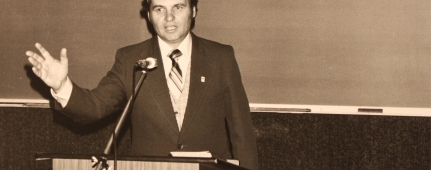The Alarming Rise Of The Evangelical Hyperbolic Hermeneutic
F. David Farnell, PhD
Introduction
This year, Protestants celebrate the 500 year anniversary of the Reformation (1517-2017). Since the days of the Reformation, except perhaps for their inconsistency in prophetic literature like the book of Revelation, the Reformers fervently championed the plain, normal, literal interpretation of Scripture. Indeed, one can say that the Reformation was at heart a hermeneutical reformation in biblical interpretation. During their day, the prevailing interpretation ideology of Romanism was allegorical, or more importantly, non-literal interpretation that had held sway for 1500 years at least.
Luther constantly denounced the empty speculations of non-literal interpretation found in Romanism. He rejected the Roman Catholic fourfold sense (literal, allegorical, moral, anagogical) of Scripture dominant through the Middle Ages because such an approach read into Scripture elements that were not only foreign to the plain, normal understanding of the text but allowed the interpreter to find in the text any concept or idea desired by the interpreter, especially when the text in its literal sense presented something unacceptable to the interpreter’s mindset. Non-literal interpretation had become the dissolvent that allowed the interpreter to make the Scripture pliable in new ways, to cause the Scripture to say whatever the interpreter wanted it to say rather than what the text said in its plain, normal, literal sense. Instead, Luther stressed sensus literalis or literal sense of the Bible. He wrote that the Scriptures “are to be retained in their simplest meaning possible, and to be understood in their grammatical and literal sense unless the context plainly forbids” (Luther’s Works, 6:509).
Jean Calvin, another great leader of the Reformation, believed non-literal interpretation was quite a frivolous interpretive approach. He believed that allegory or non-literal approach often contradicted the literal sense outright. He, too, championed that grammatico-historical exegesis of discovering what the text meant, letting the text speak for itself. The Reformers believed that the only true objective control over the speculative imagination of an interpreter was grammatico-historical-literal hermeneutics. Importantly, plain, normal interpretation placed the authority of Scripture correctly upon the Scripture itself rather than subjecting Scripture to the authority of the interpreter’s bias. Indeed, one can say that the Reformers championing of the plain, normal sense of Scripture was a radical thought in their day; it was revolutionary.
This rejection of non-literal interpretation by the Reformers showed great wisdom. Allegory or symbolic interpretation had no real objectivity or control over the imagination of the interpreter, allowing the interpreter to read into Scripture whatever the disposition of mind that interpreter desired, turning the Scripture into “putty” to make it say whatever the interpreter’s disposition currently is. Indeed, allegory is somewhat like today’s Rorschach test of amorphous blobs that are designed to bring out the cryptic disposition of people’s minds, their tendencies in thought and patterns of thinking that remain hidden.
Why do I celebrate the 500th year of grammatico-historical interpretation? Why do I raise issues of interpretation? I do so because an alarming, shocking trend has developed among evangelicals who are the heirs of the Reformation. A decided shift is occurring in hermeneutics that is gradually, inexorably moving away from Reformation hermeneutics of plain, normal, literal interpretation that has safeguarded Bible-believing people for 500 years. A strong trend backward toward non-literal interpretation has enveloped Protestantism, especially evangelicalism.
What makes this even more alarming is that evangelicals today are not only heirs of the Reformation but also benefited from fundamentalist-modernist debate of 100 years ago (1917). One need only read R. A. Torrey’s The Fundamentals original work to see that they left a monumental testimony that “higher criticism,” today known as “historical criticism” and its bent toward dismissal of the historicity, supernatural of the OT and NT, as well as its, non-literal interpretation. The Fundamentals championed the results of the Reformation, noting,
But for the mercy of God at the Reformation it [Christianity] might have been defeated But God’s Spirit brooded upon the moral and spiritual waste as erst He did upon the material in the beginning, and God’s Word said “Let there be light!” and there was light. Luther in Germany, Calvin in Geneva, and Knox in Scotland, with others in different parts, arose as champions of the Truth and recalled men’s thoughts to the simplicities and certainties of the Gospel; and a great awakening overspread the nominally Christian world (Thomas Whitelaw, “Christianity, No Fable,” The Fundamentals, 2:377).
They championed a belief in plain, normal interpretation inherited from the Reformation but also cataloged the hermeneutical road of destruction that historical criticism had perpetrated on belief in Scripture at the turn of the 20th Century. It was because of such writing and warning like The Fundamentals that Bible-believing people founded Bible schools and Seminaries in the 20th century. It may even be speculated that the Evangelical Theological Society (1949) with its emphasis on inerrancy as a corner stone of admission found its origin from this time, especially since historical-criticism fought so strongly against an “infallible” or today’s term “inerrant” (without error) Bible.
Troubling Events of the 21st Century
As evangelicals move into the 21st century, troubling signs appear on the horizon regarding not only inerrancy but the concomitant Reformation principle of grammatico-historical interpretation, i.e., plain, normal understanding. This paper will not focus on troubling events among liberal, critical scholars for troubling events among that group is always expected, indeed shocking positions among this group is really the normal. Instead, the focus here is upon evangelical, critical scholars, especially since the latter are the direct heirs of the benefits of Reformation as well as the fundamentalist-modernist debate and its scholarship comes from schools founded in the early twentieth century as a direct result.
Even more concerning is the fact that the very influential Dallas Theological Seminary founded in 1924 during the fundamentalist-modernist debate, who has trained thousands of pastors and teachers, in the 1960s to the early 1980s as evidenced by their “What We Believe” series emphasized:
1. A champion of the inerrancy of Scripture (Charles Ryrie, “What We Believe in Biblical Inerrancy”-1972) that championed “ scholarly investigation” should have a “reverence that includes a proper faith in the God of truth and His inerrant record of that truth” (p. 18). Moreover, DTS houses the records of the International Council on Biblical Inerrancy (1978) and Hermeneutics (1982) in their basement.
2. A champion of grammatico-historical hermeneutics of the Reformation (Donald K. Cambell, “What We Believe in Literal Interpretation-1974) that championed the Reformation and warned of the fatality in biblical understanding that “Departure from literal interpretation on the part of those who allegorize or demythologize as a general approach to Scripture” (p. 19) and that,
At Dallas Seminary we believe in literal interpretation. The Bible is interpreted literally, that is, in its normal or natural sense. This means that we accept at face value the biblical record of the creation of the universe and man, the historic fall of Adam in Eden, the Noahic flood, the Tower of Babel, and all other events of biblical history, both natural and supernatural. This has also led us to a system of doctrine in which the great fundamentals of the faith are affirmed and expounded including belief in such vital matters as an inspired and inerrant Scripture, the person and work of Christ, the person and work of the Holy Spirit, distinctive programs for Israel and the church, and the premillennial return of Jesus Christ (p. 21)
Yet, troubling events surround DTS graduates in terms of inerrancy and Reformation hermeneutics. Dark clouds for Dallas grow on the horizon in these areas. The present writer will reference a few concerns that highlight a closer look at what is now occurring at DTS as they appear, in this writer’s personal opinion, to be not only leaving their former reptutation in the “What We Believe” series but are now evidencing a growing departure from plain, normal interpretation, and instead, evidencing a trenchant toward non-literal allegorizing as well as denial of the inerrancy of Scripture.
Hyperbolic Use of Population Numbers in the Old Testament as a Hermeneutical Principle
In 1992, a Dallas Seminary, Old Testament Department graduate, David M. Fouts wrote his dissertation entitled “The Use of Large Numbers in the Old Testament with Particular Emphasis on the Use of ‘elep.” A condensed form of this dissertation appeared in the Journal of the Evangelical Theological Society in 1997. Fouts found troubling many literal numbers in the Old Testament, arguing that “For some scholars the use of large numbers in the OT is an interpretive issue. For others it involves the theological issues of inerrancy and the historical veracity of Scripture.” He argued that his article’s purpose was “to demonstrate and defend the premise that he issue is hermeneutical rather than theological, involving interpretation rather than inerrancy.” (Fouts, JETS 40 [Sept 1997] 377. He examined issues surrounding five examples of population figures in the text of the OT. I will highlight only three:
1. The population of Israel at the Exodus, i.e., the size of the Israelite nation given in the OT (i.e., Num. 1:45 at 603, 550 total) as well as the size of the Israelite population just before conquest in Numbers 26:51 at 601, 730).
2. The number of the Ephraimites in Judges 12. Judges 12:6 gives a number of slain at 42, 000 for mispronouncing “Shibboleth,” but that such a number “exceeds the census for that tribe in either Numbers 1:32 (40,500) or Numbers 26:35 (32,500). Fouts asserts “Even allowing for an increase of the Ephraimite warrior population after the conquest does not alleviate the problem of the enormity of the number of those slain.” (p. 378).
3. The Davidic census in 2 Samuel 24: at 1.3 million and 1 Chronicles at 1.57 million arguing that “Like the censuses of the book of nUmbers, the totals are entirely too large.” (p. 379).
Based on this reasoning concludes, “Those who would challenge an essentially conservative view of Scripture often do so by appealing to such passages that involve large numbers” (p. 379). He continues, “Accepting them at face value often leads to internal disharmony with other Biblical passages. There are also the archeological data to contend with. These facts may no longer be ignored by conservative scholars.” (p. 379). He says that “What is needed is a balanced approach that examines the numbers as they are encountered in the text and suggest a plausible explanation of their use consistent with other Scriptural data and with the demographics demonstrated by regional archeology.” (p. 379).
Next, based on an examination of (1) a brief review of the history of interpretation of these numbers that asserts a rejection of these numbers as true but rather allegorized them [with the exception of the Reformers who took them literally—PLEASE NOTE: [notice they were grammatico-historical advocates of literal interpretation] (pp. 379-81); (2) textual consideration in the OT that affirm these large numbers as being indicated in the original Masoretic text, especially by the Hebrew term for “thousand” (‘elep) being accurately understood as such a large number so that there is no substantive doubt that large numbers are truly indicated in the MT (pp. 381-82), (3) current archeological and demographics discoveries that suggest at no time did the land contain such a large population as seen in Numbers 1; 26; and (4) Ancient populations around Israel employed “hyperbolic fashion” in their literature regarding in “military contexts expressing the number of troops enaged in battle, number of enemies slain or captured, amount of spoil taken and amount of corvée labor employed” (p. 383-84).
He concludes that the OT is similar to ancient history writing in use of hyperbole. “Scripture is similar to other ancient historiography in that it may use large numbers hyperbolically in military contexts” (p. 386). He concludes that one must understand these large numbers as hyperbolic. Fouts concludes that the OT reflects, especially in 1-2 Chronicles, “a literary pattern of hyperbole, the purpose of which is to glorify both Yahweh and his theocratic ruler David (and his descendants)” (p. 387) . . . . “the choice of the size of the numbers may have been due to authorial intent rather than a strict accounting of factual figures” (p. 387). Finally, he states,
[T]he large numbers have often been a stumbling block for accepting the Biblical accounts as legitimate records of history. If the numbers are simply reflective of a rhetorical device common in ancient Near Eastern literature, however, one may no longer question the integrity of the record of use of this argument. The large numbers are often simply figures of speech employed to magnify King Yahweh, King David, or others in a theologically based historiographical narrative. (p. 387).
Several comments are in order for DTS graduate Fouts that need to be evaluated.
1. It is good that Fouts appears to give credibility to the Bible as well as inerrancy. But one is left wondering just what he means by the term “inerrancy” as one examines his contentions. Clearly a shift from historically, traditional, orthodox understanding of the term has occurred by examining his “solution” here. Obviously, ICBI inerrancy standards are clearly violated by ICBI standards of 1978:
ARTICLE XVIII:
We affirm that the text of Scripture is to be interpreted by grammatico-historical exegesis, taking account of its literary forms and devices, and that Scripture is to interpret Scripture.
We deny the legitimacy of any treatment of the text or quest for sources lying behind it that leads to relativizing, dehistoricizing, or discounting its teaching, or rejecting its claims to authorship.
Clearly, Fouts dehistoricized. Perhaps as he does not believe in ICBI?
2. How does Fouts know the mind or “intent” of the OT writers? Is he a mind reader?
3. All we have are these numbers given in the text literally. Grammatico-historical interpretation accepts these numbers at face value in light of no compelling reason textually to dismiss them. Fouts has now stepped away from plain, normal and subjectively imposed non-literal or allegorical or, what he calls, “hyperbolic” rhetorical devices or “simply figures of speech.” Plain, normal interpretation is directly tied to ICBI Inerrancy
4. Would the original readers have picked up any clues in the context that the writer “intended” hyperbole? Examining the context of these places evidences prose, not poetic, literature, written in a very factual nature.
5. How is God glorified by figures that have no truth correspondence to reality? If the figures are not actual numbers, then how is God glorified through obvious deceit of hyperbole that might not be recognized as the “intent” of the writer or recognized by the reader of these documents as hyperbole. Common sense would suggest that hyperbole on Fout’s supposition assaults the character of God not affirm it.
6. Inerrancy accepts that the text of Scripture is without error. Fouts hermeneutic of hyperbole assaults the doctrine of inerrancy rather than affirms it as he contends. The Scripture is made to bow to the fleeting/temporary evidence of archeology and demographics. The Scripture, its integrity, its trueness, is made to bow before the subjective whims of historical criticism evidenced in his analysis. In essence, his approach is a pig with lipstip in that it assaults inerrancy rather than upholds it.
7. It is also non-sequitur to say that because others did this during Israel’s day that Israel followed suit.
8. Above all, his “solution” or “remedy” is worse than the “disease” he addresses. By attempting to resolve the difficulty, he creates a bigger difficulty. If the OT exaggerated numbers, why not exaggerate other things? Why stop there. Why not invent other exaggerations regarding the Fall (e.g., a talking snake; rib from the side of Adam), The Flood (e.g., a mere thunderstorm becomes a flood), the Exodus (some small group of Jews who wander out of Egypt becomes an exaggerated deliverance)?
Hyperbolic [i.e., “Exaggerated”] or Symbolic Use of Lifespan Numbers in Genesis as a Hermeneutical Principle
Another more recent DTS graduate shares a similar type of non-literal interpretation rather than plain, normal interpretation once championed by DTS. At the Evangelical Theological Society on November 15, 2017, at Providence Rhode Island, DTS graduate Craig Olson presented an interesting paper along similar lines to Fouts. Olson is a PhD graduate of Dallas Theological Seminary, receiving both his ThM in “Academics and World Ministries” (2007) and PhD in Bible Exposition (2017) from the school. He teaches at DTS as well as a class on hermeneutics at Trinity Southwest University in Fall 2017. In 2013, Olson received the Donald K. Campbell Award in Bible Exposition. He also is associated with Josh McDowell ministries.
At the ETS meeting, Olson wrote a paper entitled, “How Old was Father Abraham? Why the Patriarchal Lifespans Cannot be Face Value Numbers. A Paper Presented to the Annual Meeting of the Evangelical Theological Society, November 15, 2017.” Reflecting similar thinking of hyperbole to Fouts, Olson argues in his “Abstract” portion of the paper that,
The long lifespans in Genesis are only a problem for those who hold to inerrancy. If the patriarchal narratives are merely legends, then exaggerated lifespans fit right in. However, for those who believe Genesis records actual events about real people, the lifespans raise significant questions. Skeletal and tooth wear data from ancient times indicate an average lifespan of around forty years old, not over 900 years as in Genesis 5, or even the almost 200 years of the later patriarchs. But the problems are not limited to scientific data outside the Bible. A face-value reading of the patriarchal ages contradicts other Scriptures. Plus, a chronology based on these lifespans is biblically inconsistent and contradicts the archaeology of the Intermediate Bronze and Middle Bronze ages.
He goes on to argue that,
This paper will outline reasons from both inside and outside the Bible why the patriarchal lifespans were never intended to be read as face value numbers and will survey a history of interpretation. This paper proposes that Genesis genealogies reflect the authentic Middle Bronze Age practice of using schematic and exaggerated lifespans to bestow honor on significant ancestors. A symbolic interpretation of the patriarchal lifespans from an evangelical perspective will be proposed and defended, and the proposal will be applied to other extraordinary lifespans in Scripture. [red highlight added]
In this article, Olson contends that questioning the lifespans of the OT text does not question inerrancy. He argues that
Evangelicals have traditionally claimed that to question the face value interpretation of the lifespans in Genesis is to question the inerrancy of the text. However, the truth is actually the opposite. The long lifespans of the patriarchs present a problem for those who believe that Genesis records actual historical people and events. The Chicago Statement on Inerrancy states that “Scripture is without error or fault in all its teaching … about the events of world history.'” But these lifespans are outside the known extent of human longevity and seem to add a mythical or legendary quality to the narratives. There is no evidence of anyone at any time in history living these types of lifespans, and a chronology based on a face value reading does not match the archaeological evidence we find in the ancient Near East. So, taking the ages in Genesis at face value actually undermines the historicity of Genesis and exposes the text to the possibility that it is historically inaccurate. [red highlight added]
In Olson’s thinking, to accept these lifespan ages at face value undermines historicity and actually assaults inerrancy. Why? He gives several reasons, essentially centering on problems “outside the Bible” and problems “inside the Bible”
1. “[E]xtended lifespans clearly contradict all known evidence. . . . . There has not been presented any credible archaeological or anthropological evidence of any human living past 120 years old..” So he believes there is a scientific problem based on discovered evidence to date.
2. If we accept long lifespan figures, “The events recorded in Genesis could not have occurred during the IBA [Intermediate Bronze Age—1950-1800 BC). So he believes there is a chronology problem based on current understanding of ancient times.
3. He goes on to cite various alleged chronological problems “within” the Bible based on his understanding of the apparent contradictions that might arise if long ages are accepted among the Patriarchs.
4. He then reviews the history of interpretation of long patriarchal lifespans in Jewish and Christian history. He notes that “written records of how people interpreted the lifespans in Genesis do not appear until after ca. 300 BC” so one cannot be certain as to how the ancients interpreted lifespan due to the “time gap.” He notes that some Jewish interpreters (e.g., Demetrius the Chronographer [ca. 200 BC], Eupolemus [ca. 160 BC], the book of Jubilees [ca. 150 BC], and Josephus [in Antiquity of the Jews, ca. AD 94] “all took the numbers in Genesis at face value.” The LXX “showed a willingness to change the numbers for their own purposes.” Christian chronographers such as Julius Africanus [AD 221], Eusebius as well as Archbishop Ussher [mid Seventeenth century AD] took them at face value. But he dismisses this as due to a belief in a strict 6000 years of history corresponding to six days of creation. He also notes that the Reformers [Luther, Calvin] took these lifespans at face value. Yet, he argues that “the evidence does not support the common notion that everyone interpreted these lifespans at face value until the nineteenth century.” The evidence that he does cite does indeed show this latter contention so one is left wondering about his contention here!
His proposed solution to the “problem” of long lifespan ages in the following terms,
If we abandon the face value interpretation of the patriarchal lifespans are we not simply appropriating the findings and assumptions of the critical scholars?
The answer is no. A symbolic interpretation of the patriarchal lifespans from an evangelical point of view holds that these schematic numbers were part of the original composition of Genesis by Moses after the Exodus . . . .
My contention is that these patriarchal lifespans were originally written as schematic numbers intended to memorialize and convey honor to the lives of real ancestors who played significant roles in the founding of the nation Israel. I believe that a better understanding of how ancient cultures recorded lifespans will not only lead to a more accurate biblical interpretation, but also align the patriarchal narrative with the chronology of the patriarchal age and known archaeology from the Middle Bronze Age. This interpretation can restore faith in the historicity of the patriarchal narratives by removing the conflict between the face value interpretation and the historical evidence.
Therefore, Olson rejects the concordance view that believes such contradictions between science and the Scripture would be debunked through future discovery. He also rejects that God has accommodated himself to fit a pre-scientific world view. His conclusion is that they are symbolic numbers “to memorialize and convey honor to the lives of real ancestors who played significant roles in the founding of the nation of Israel” and “the patriarchal lifespans are in error if the original author intended them to be accurate historical records, and the audience accepted them as such.”
Some replies to Olson are in order:
1. All the Criticisms directed at Fouts apply here to Olson for their hermeneutic is very similar. They negate the plain, normal sense of Scripture, the grammatico-historical sense, due to rationalistic reasons. Please review the criticisms above Fouts.
2. The overwhelming evidence is that as far as one can determine, the vast majority of orthodox individuals, from Jewish to Christian, took these numbers at face value.
3. Once again, why stop the “hyperbolic hermeneutic” to just the area of lifespan in 2017? Fouts has already extended it to population figures in 1992. Where will this stop? Perhaps the entire book of Genesis 1-11 is a hyperbolic, non-literal account. Nothing stops Olson’s approach from explaining away many other “problem” areas in the OT/NT.
A Critical Commentary On The Current State Of Evangelicalism
If one compares the statements of DTS’s “What We Believe” cited here and what some of their graduates now advocate, one has growing concern. Some observations:
1. DTS’s reputation for upholding the Inerrancy, Grammatical-Historical Interpretation, and Full plenary, verbal inspiration of the OT/NT from 1924 to around the time of the “What We Believe” in the 60s to early 80s was arguably impeccable. Grave doubt now grows today as evidenced by its graduates. The evidence is not matching the Seminary’s contentions any longer of its doctrinal statements of “What We Believe.”
2. An old church history professor once taught this writer of the article that any seminary is doctrinally sound and faithful only to the third generation. The first generation of a Bible College or Seminary breaks away from assault on Scripture (the fundamentalist vs. modernist conflict) and knows the horrors of the assault on Scripture. The second generation of these schools begins to forget; not pass on the lessons of history to incoming graduates. By the third generation, the school begins to exhibit the same doctrinal-spiritual problems that caused the founding of the school in the first place. DTS is in its third or fourth generation.
3. The refutation of both Fouts and Olson stand, in reality, just by listening to them. They clearly apply rationalistic arguments that violate inspiration and inerrancy all the while contending that their views affirm it. Their affirmation is really a denial!
4. I was a graduate of Dallas Theological Seminary in 1990 from the Department of New Testament with my PhD. I witnessed things advocated in the Department that clearly were in contradiction to I long believed DTS stood for. I was during my 4 years there often shocked by the advocacy of some of those in the NT faculty. I could write many more pages, but I don’t feel this is the place. At least now anyway. My experience was one of being berated with verbal threats and raised voice if I did not accept the “enlightenment” of historical-critical ideologies. I witnessed an incident of someone singled out for removal from the program when they dared object to historical criticism. I only graduated by God’s grace who protected me during those years. The “new DTS” that I experienced was not the “Old DTS” that I heard about from my teachers who graduated from there.
5. The evidence is now seriously suggesting something may well be wrong both spiritually and doctrinally among evangelicals, and DTS in particular. In the OT, a Hebrew word “ICHABOD” or “no glory” or “the glory has departed” may well be applicable (1 Sam 4:21). The words of Revelation 2:5 to Ephesus may also, “Remember therefore from where you have fallen; repent, and do the works you did at first. If not, I will come to you and remove your lampstand from its place, unless you repent.”
6. Finally, the present writer has noticed an inverse proportion of the prestige and influence of a seminary. Simply put, the more Bible-believing a seminary is, the less influence and prestige it has among the world as a whole; the more liberal or unbelieving a seminary becomes, the more prestigious the world considers the institution. I believe THAT MY DTS DEGREE IS BECOMING VASTLY MORE PRESTIGIOUS.
7. ETS clearly has drifted in its definition and understanding of inerrancy in its membership.














